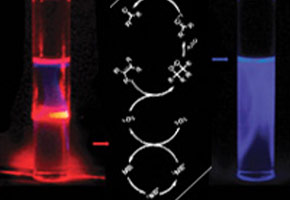

Brazilian researchers in partnership with German scientists transform red light to blue with a chemical reaction
Brazilian researchers in partnership with German scientists transform red light to blue with a chemical reaction
Brazilian researchers in partnership with German scientists transform red light to blue with a chemical reaction

Brazilian researchers in partnership with German scientists transform red light to blue with a chemical reaction
By Elton Alisson
Agência FAPESP —Transforming red light into blue light, which has higher energy, is common in the field of physics through the use of optical techniques. But until now there was no chemical method for the conversion.
Researchers at the Institute of Chemistry at the Universidade de São Paulo (USP) and the Center of Natural and Human Sciences at the ABC Federal University (UFABC) in partnership with scientists from the Institute of Organic Chemistry and Macromolecular Chemistry at the Friedrich Schiller Jena University in Germany put together pieces of the puzzle and developed a method that uses chemical energy to convert the radiation of red light into the emission of blue light.
The experiment was described in the cover story in the April edition of New Journal of Chemistry, published by France’s National Center for Scientific Research (CNRS). The article is available on the internet.
To transform the colors of the light, the scientists used a red laser that promotes a chemical reaction between oxygen and an organic molecule. The product of this reaction is an unstable high energy compound called dioxetane. At room temperature, dioxetane decomposes, releasing its energy in the form of blue-colored light in a process known as chemiluminescence.
“It’s like making water fall up a waterfall. With this chemical reaction, we managed to make the light’s energy flow uphill,” said UFABC professor Erick Leite Bastos, one of the authors of the study that spoke with Agência FAPESP.
According to the researcher, both the use of light in preparing dioxetane and its chemiluminescence (the emission of light when the compound decomposes) were already known.
However, these two discoveries had not been brought together in a system where the light used to form the dioxetane had less energy than the light emitted during its decomposition. “What we did was to bring all the stages of the process together, creating something absolutely new,” he affirmed.
Possible applications
In the article, the researchers describe only the basic mechanism of the chemiluminescent reaction, but according to them, the discovery could have a wide range of applications.
Among the possibilities are highly sensitive analytical systems for detecting the presence of oxygen in a biological environment, image capturing mechanisms, signage and cryptography.
“We hope that other scientists find completely new applications that we can’t even imagine today,” said Josef Wilhelm Baader, professor at USP’s Institute of Chemistry and main author of the study.
A German living in Brazil for over 20 years, Baader develops studies on the basic mechanisms involved in chemiluminescent transformation. The collaboration with the group in Jena coordinated by Rainer Beckert began over ten years ago and allowed for many post-graduate student exchanges.
It was during post-doctoral corporate research at the Jena University financed by EMP Biotech that the study’s first author, Luiz Francisco Monteiro Leite Ciscato, had the idea to develop a method for transforming light.
“The idea came about during the creation of an industrial protection system against falsification based on chemiluminescence,” said Ciscato.
The article Chemiluminescence-based uphill energy conversion (doi:10.1039/C0NJ00843E) can be read at:. http://pubs.rsc.org/en/content/articlelanding/2011/nj/c0nj00843e.
Republish
The Agency FAPESP licenses news via Creative Commons (CC-BY-NC-ND) so that they can be republished free of charge and in a simple way by other digital or printed vehicles. Agência FAPESP must be credited as the source of the content being republished and the name of the reporter (if any) must be attributed. Using the HMTL button below allows compliance with these rules, detailed in Digital Republishing Policy FAPESP.





